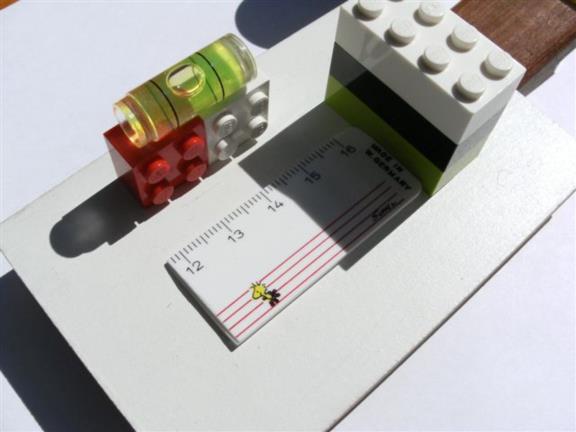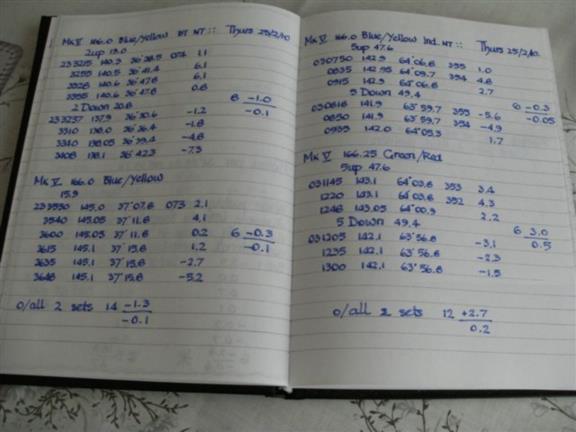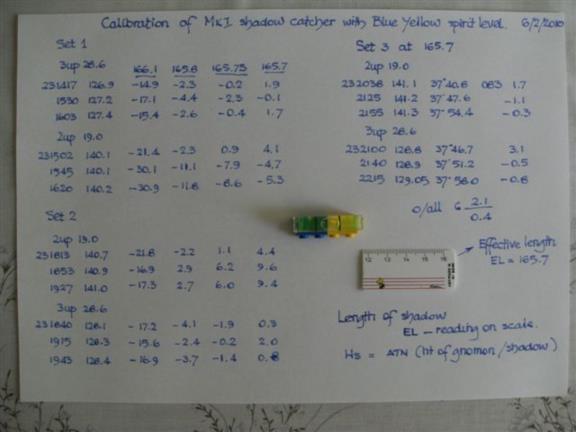
NavList:
A Community Devoted to the Preservation and Practice of Celestial Navigation and Other Methods of Traditional Wayfinding
From: John A Brown
Date: 2010 Mar 5, 05:31 -0800
When I bought a Davis Mark 3 sextant about 15 years ago I was full of enthusiasm for learning the art of taking sun sights. However, as I live about 8km from the coast and my back garden has too many trees to make the use of an artificial horizon very practical, I looked around for a way of taking sun sights without a sextant. After noticing shadows cast by my desk lamp, I thought that this might be a way to proceed. I could find no positive references to the subject in my collection of nav books. On the internet I found many references but the vast majority were related to school projects and all seemed to start with the formula "take a metre ruler". The instrument I finally came up with is the shadow catcher and it bears the same resemblance to the metre ruler as the Bris sextant bears to the full sized instrument. I gave it the name shadow catcher as this sounds much better than "a little bit of ruler" which in fact it is. The idea of the shadow catcher is stolen from the ancient Egyptians, but the remainder is, as far as I am aware, original.
After about ten years of hit and miss efforts I saw a picture of an Egyptian shadow clock. In essence this is just a graduated stick with a gnomon at one end. It looked a promising new way to take sights. I had already developed the shadow platform for levelling and I had already discovered a precisely engineered multi-height gnomon, also known by it's trade name Lego. The idea of virtual levelling came a little later and before long I had a complete sun sight kit that fits into a small tin.
The essential components for shadow sights are a platform on which the sights are taken, a spirit level to make the platform "level", a gnomon to cast the shadow and a small length of ruler to measure the shadow. When the small piece of ruler is glued to a base it then becomes a shadow catcher. Additional to this is a watch set to UTC and a magnifying glass as the shadow has to be measured to the nearest tenth of a millimetre. I use the front lens assembly from a pair of 7 x 20 binoculars but any magnifier will do. Calculations are done by a twenty year old Radio Shack PC-6 programmable pocket computer and all sights are worked from the same position so that an average of the intercepts for each set of sights can be found.
The shadow platform consists of a piece of 70 x 110 MDF painted white. It is supported at one end by two pieces of Blue Tack in the corners and at the other by a cut down door wedge which provides very precise control in levelling. The end of the platform with the wedge is pointed towards the sun before levelling. The platform is then levelled crosswise with the spirit level by pressing on the corners as required over the Blue Tack and then levelled lengthwise using the wooden wedge. The platform can also be used to support a small mirror to take star sights with a sextant.
The height of the gnomon is selected so that when it is placed across the end of the ruler it produces a shadow that lies about halfway along the ruler with an edge that is crisp and can be easily measured. This is very important. Short, very sharp shadows can give errors of over 20nm per one tenth of a millimetre. The gnomon is made up of different combinations of Lego blocks. I use the standard 2 x 8 blocks and they can be used in either the "up" or "down" position. Combinations do not measure as multiples of a single block so each combination has to be carefully measured and a record kept for future use e.g. 3up 28.6mm, 3down 30.5mm. Because Lego is such a good product you only need to do the measurement once and any set of blocks will measure the same as any other set of equal number. Damaged blocks should not be used as this can affect the contact with the end of the ruler.
The ruler is a small 40mm segment taken from the end of a 160mm plastic ruler. The end is square so that the gnomon is at right angles to the scale. The blank bit at the end of the ruler is 6.1mm. Therefore the nominal length of the ruler is 166.1mm and the length of the shadow being measured is this length minus the reading on the scale e.g. if the scale at the end of the shadow reads 135.2 then the length of the shadow is 166.1 minus 135.2 which is 30.9 mm. The sun's altitude, Hs, is found by the formula Hs = inverse tangent ( ht of gnomon / length of shadow ). Allowance for refraction is as for stars and planets as the sun's lower or upper limb is not involved. Of course this can only be of any use on a truly level surface. I guess that this is why the books don't deal with shadow sights even for emergency navigation.
When I started this exercise I was amazed to find that no two spirit levels agreed and even the same spirit level when reversed would not agree with it's other side. One day, whilst playing around with a bubble vial, I noticed that when it was placed over a vertical line drawn on a piece of paper there was only one position where the line appeared straight. I had been using bubble vials mounted on single 2 x 8 Lego blocks for some time but now I tried to duplicate what I had seen on the piece of paper. I glued two 2 x 2 Lego blocks together, one red and one white to give a colour contrast. I glued the bubble vial centrally over the join and at right angles to it. I found that when I placed the new spirit level on the shadow platform, unless the spirit level was exactly "level", the colour of one block would appear to "run" into the colour of the other block and there was only one position where the line was straight. This meant that I could very accurately repeat this level anywhere. It was a virtual level that had no relationship to any real level but if I could calibrate the ruler to accept this level as the real level then this might be the way to overcome the main problem of shadow sights. When levelling the shadow platform lengthwise, the spirit level should be viewed at about 15 to 20 degrees from the vertical and always viewed from the same side. When levelling crosswise it is easier to view the spirit level vertically.
I normally take sights in sets of six, mainly because it allows two sets to fit nicely on one page of my notebook. I took three sets of sights. It took about eight minutes to take the 18 sights. When sights are taken a note is made of the shadow catcher being used, the spirit level, the gnomon and its height, the time of the sight in UTC and the "length" of the shadow which the pocket computer will deduct from the nominal length to give the true length. The pocket computer calculates altitude, Hs, and after allowing for refraction, calculates and displays azimuth and intercept. I put the third set of sights aside and worked out the first two sets using 166.1mm as the nominal length of the ruler. I only recorded the intercepts. They were all in excess of 20nm. I then recalculated using a different nominal length for the ruler. Gradually, after about four recalculations of the first two sets, and just noting down the intercepts, I reached a length that gave a very satisfactory result. Some intercepts + and some - so that when added together and divided by the number of sights gave an average intercept fairly close to zero. I then took the third set of sights, and using the new "effective length" that I had just found, I calculated the six sights in full. This gave an average intecept of about a mile or so. The ruler had been calibrated for use with this particular spirit level. Each spirit level that I have made up is of a different colour combination to avoid confusion. The true test comes of course the next day when more sights are taken. I have found that in nearly every case the "effective length" that was originally calculated has worked to give good results and no further calibration is required.
Of course shadow nav has its drawbacks - the biggest being that it cannot be used afloat. The results are sometimes disappointing, but the disappointments are by far outweighed by the elation of getting good results from such simple equipment. I'm sure the method won't stand up to scientific scrutiny and I am rather hesitant to put it forward as a serious proposition but I have had such enjoyment from using this method of sun sights that if only one other person was to try it and find it to their liking then I am happy to take any criticism that may come my way.
The attachments show the following -
SCa All the elements of the system.
SCb Shadow catcher in action showing what is recorded. The SC is in emergency mode with four pieces of blue tack used for levelling instead of the shadow platform. It is placed on a larger shadow platform to allow for alignment in azimuth. When calculated this set of sights produced intercepts of less than 1nm from five of the six sights. The other was 3.7nm
SCc Pages from my notebook of one day's sights. A better than average day but certainly not unusual.
SCd The resultant position and the equipment used.
SCe The method used to calibrate a ruler. Only the intercepts recorded for the first two sets and the third set shown in full.
Regards
John Brown.
Adelaide, South Australia.
----------------------------------------------------------------
NavList message boards and member settings: www.fer3.com/NavList
Members may optionally receive posts by email.
To cancel email delivery, send a message to NoMail[at]fer3.com
----------------------------------------------------------------











